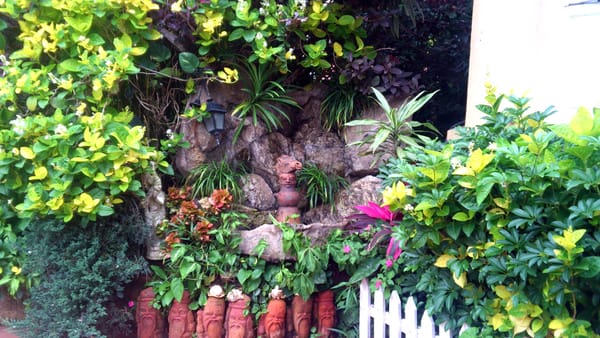As one walks into Silverend, Mohan and Priya Mascarenhas’ 130-year-old heritage home, the greenery around envelopes you. The fragrance of the flowering plants and the carefully laid out beds makes one halt in one’s tracks to take in the breathtaking array of Nature’s bounty that surrounds along the tiled pathway leading to the home. The soft sounds of wind chimes, the birds chirping and butterflies hovering around the flowers take you to a bygone era. You will wonder if this is indeed a home in Urban Bengaluru. Silverend has also won awards for the Best Old Home from the Urban Arts Commission.
Unconventional atractive designs in Priya Mascarenhus’ garden. Pic: Snehalatha Naidu
With a coffee plantation background, it comes as no surprise that Priya was fascinated by plants since a very early age. Having all green fingers (not just a green thumb) helped fuel her desire to have plants play a very important role in her life.
Champa, Priya’s younger daughter with special needs, was another reason to painstakingly put together a green haven as she loved the water bodies and the fountains that one finds placed in strategic nooks and corners in the garden.
Plants of all shapes and sizes adorn Priya’s elegant piece of paradise, often called Garden of Eden. Many are from her sojourns abroad, most are the result of her ever-curious eye that can spot an unusual variety at a friend’s home. Quite a few are gifts from friends who know her passion for greenery.
Plants of different textures, tropical, local and from many parts of the world in various hues, shades and sizes are personally supervised by Priya who spends many hours a day, placing artefacts like statues and pottery items to enhance and add to the beauty of her green babies.
Heliconia is Priya’s signature plant. She has them in so many varieties all over the place. Her daughter Nisha has also contributed to her collection from her garden at the coffee estate.
Landscaping that renders an otherwordly feel to the garden. Pic: Snehalata Naidu
Lobster Claws, Wild Plantains, Ginger Lillies, Moosas and Birds of Paradise are the common names for the magnificent flowers that overpower all others in her garden. Prize winning Ferns, Asparagus and Anthuriums peep out from their pots strategically placed at corners.
While Priya has many species and varieties in her garden, one cannot miss the grandeur of the Heliconias and Ferns. Fruit trees like figs, star berries, rose apples, mangoes, breadfruit, sapotas, bulls heart etc hold the garden together along the boundary walls.
Passion is a perfect word to describe executive-turned-gardener Priya’s lifelong love story with plants. Seeing the carefully tended, meticulously arranged beds and bushes, it is no wonder that Priya’s Boutique Garden has won accolades, trophies and cups from the Lalbagh Horticultural Society for 35 years in a row, on Independence Day and Republic Day. The horticulture judges unanimously declare that hers is the most aesthetically maintained, outstanding garden in Bangalore. She has won 52 cups and trophies to date. Remarkable and awe-inspiring feat indeed!
The latest feather in the cap at the Independence Day show is the Javaraya Trophy for the Outstanding Ornamental Garden. Despite being a businesswoman and Director in Metters International assisting her husband, her unstinted determination and excellent time management help Priya maintain her garden, braving all odds and the challenges.
Related Articles
Gardening isn’t rocket science!
Reap the benefits of gardening
Bengaluru going big on home gardening

